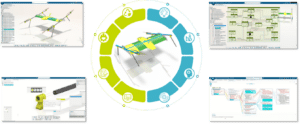
Local Hawk – MBSE in Real Life
Table of contents
ProTECHting People & Planet
KONGSBERG is a Norwegian-based, global enterprise, specialized in developing advanced technologies to provide extreme performance for extreme conditions, across a wide range of applications and industries. Their slogan, “ProTECHting People & Planet”, symbolizes the dedication of the entire group to provide technological solutions to help overcome some of the biggest challenges currently faced by humanity. The military division, Kongsberg Defence & Aerospace (KDA), develop world class defense systems, some of which are instrumental in protecting civilian lives and critical infrastructure in Ukraine from missile and drone attacks.
The Art of Mastering Chaos
Modern defense systems are highly complex, and the development of a completely new generation can take a decade or more of advanced engineering. This is a driving force behind the transition to digital engineering, where MBSE is one of the cornerstones. Traditionally, the main carriers of engineering information are documents and drawings. During a typical defense system development program, these would easily add up to 10s of thousands, which creates a big challenge in terms of information management. If one single requirement or specification is changed, there might be an impact across hundreds or even thousands of other documents. Oluf Tonning is a group leader for systems engineering at KDA. Along with his team, Oluf keeps all “the loose ends” together, to control chaos, according to himself.
“Being a systems engineer does not necessarily mean that you are systematic. It is largely about controlling chaos. Systems engineering is the actual engine of the projects, and MBSE is an invaluable tool to keep track of all the critical pieces of information.”
Oluf Tonning, Group Leader, Systems Engineering
Image credits: Helene Strøm Bergset, KONGSBERG
Read original interview in Norvegian here: Kaoskontrolløren – Kongsberg Defence & Aerospace
Systems thinking is at the core of everything they do at KDA, and MBSE has been established as a preferred approach for more than 10 years already, but methodology alone is not enough. To cope with the complexity, and efficiently keep track of all the information, Oluf and his team use the market leading modelling tool for MBSE, CATIA Magic on the 3DEXPERIENCE platform, to bring their ideas to life and collaborate efficiently with the other engineering disciplines, including mechanical, electronics and software, to ensure the final system fulfil all operational requirements.
«Local Hawk» – Showcasing MBSE
The details concerning the products and systems developed by KDA are of course subject to strict regulations in terms of what can be disclosed to the public. So, in order to illustrate what the model-based approach means in practical terms, we need to exemplify with an un-classified project that uses the same tools and methods. Every summer, KDA invites a group of engineering students to take on the challenge of designing, developing, and building an autonomous drone, named the «Local Hawk».
While this is a relatively simple product, it still requires the collaboration of several engineering disciplines, including mechanical, electrical, software and aerodynamics. In a traditional way of working, a huge number of documents would have to be created to fully describe all aspects of such a product. Switching to a model-based way of working, the documentation effort is greatly simplified.
Figure 1 One digital model – many different views
When working model-based, the model, or rather models, are the main carriers of information. The mechanical design is captured as a 3D-model, the structural strength is verified using a finite element model, and the behavior of the system is described as a system model. The system model contains requirements, use cases, state diagrams, logical building blocks, test cases and more. Tying all these elements together puts the engineering team in full control of all important aspects of a product, to better predict how it will perform in real life. After the product is operating, the system model provides full traceability to quickly find the root cause. In case of failure during operation. The combined model can be seen as a virtual twin of the drone, helping engineers to simulate and analyze the consequences of design decisions at a very early stage.
In Our Experience
Overall, MBSE promotes a holistic and collaborative approach to systems engineering, facilitating better communication, coordination, and understanding among multidisciplinary teams involved in the development of complex systems. MBSE has proven to be a very efficient approach to rationalize complex systems development, by connecting all engineering disciplines and providing full traceability from requirement to solution. MBSE allows engineers to focus on improving the product, rather than writing documentation. Combining model-based design with MBSE leads to a much more efficient engineering process, with better performing products, and shorter development cycles as a result.




